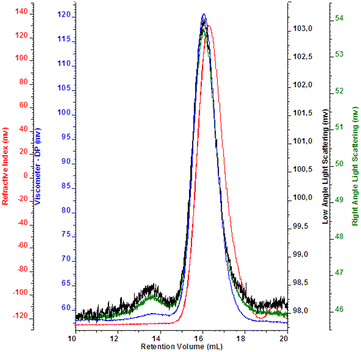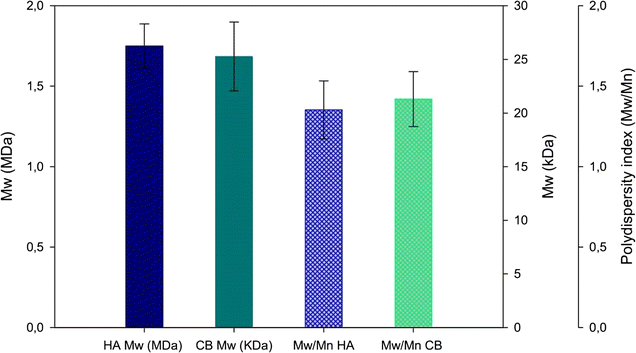Engineering S. equi subsp. zooepidemicus towards concurrent production of hyaluronic acid and chondroitin biopolymers of biomedical interest
- PMID: 28293868
- PMCID: PMC5350083
- DOI: 10.1186/s13568-017-0364-7
Engineering S. equi subsp. zooepidemicus towards concurrent production of hyaluronic acid and chondroitin biopolymers of biomedical interest
Abstract
Glycosaminoglycans, such as hyaluronic acid and chondroitin sulphate, are not only more and more required as main ingredients in cosmeceutical and nutraceutical preparations, but also as active principles in medical devices and pharmaceutical products. However, while biotechnological production of hyaluronic acid is industrially established through fermentation of Streptococcus spp. and recently Bacillus subtilis, biotechnological chondroitin is not yet on the market. A non-hemolytic and hyaluronidase negative S. equi subsp. zooepidemicus mutant strain was engineered in this work by the addition of two E. coli K4 genes, namely kfoA and kfoC, involved in the biosynthesis of chondroitin-like polysaccharide. Chondroitin is the precursor of chondroitin sulphate, a nutraceutical present on the market as anti-arthritic drug, that is lately being studied for its intrinsic bioactivity. In small scale bioreactor batch experiments the production of about 1.46 ± 0.38 g/L hyaluronic acid and 300 ± 28 mg/L of chondroitin with an average molecular weight of 1750 and 25 kDa, respectively, was demonstrated, providing an approach to the concurrent production of both biopolymers in a single fermentation.
Keywords: Chondroitin; Co-production; Hyaluronic acid; Streptococcus equi subsp. zooepidemicus.
Figures




Similar articles
-
Homologous overexpression of RfaH in E. coli K4 improves the production of chondroitin-like capsular polysaccharide.Microb Cell Fact. 2013 May 9;12:46. doi: 10.1186/1475-2859-12-46. Microb Cell Fact. 2013. PMID: 23659469 Free PMC article.
-
Highly efficient production of hyaluronic acid by Streptococcus zooepidemicus R42 derived from heterologous expression of bacterial haemoglobin and mutant selection.Lett Appl Microbiol. 2016 Apr;62(4):316-22. doi: 10.1111/lam.12546. Lett Appl Microbiol. 2016. PMID: 26784013
-
Increase in hyaluronic acid production by Streptococcus equi subsp. zooepidemicus strain deficient in beta-glucuronidase in laboratory conditions.Appl Microbiol Biotechnol. 2006 Jul;71(4):415-22. doi: 10.1007/s00253-005-0173-9. Epub 2005 Nov 15. Appl Microbiol Biotechnol. 2006. PMID: 16292534
-
Comprehensive review on biotechnological production of hyaluronic acid: status, innovation, market and applications.Bioengineered. 2022 Apr;13(4):9645-9661. doi: 10.1080/21655979.2022.2057760. Bioengineered. 2022. PMID: 35436410 Free PMC article. Review.
-
Comprehensive review on biosynthesis of hyaluronic acid with different molecular weights and its biomedical applications.Int J Biol Macromol. 2023 Jun 15;240:124484. doi: 10.1016/j.ijbiomac.2023.124484. Epub 2023 Apr 15. Int J Biol Macromol. 2023. PMID: 37068534 Review.
Cited by
-
A Review of Chondroitin Sulfate's Preparation, Properties, Functions, and Applications.Molecules. 2023 Oct 15;28(20):7093. doi: 10.3390/molecules28207093. Molecules. 2023. PMID: 37894574 Free PMC article. Review.
-
Gelatin-biofermentative unsulfated glycosaminoglycans semi-interpenetrating hydrogels via microbial-transglutaminase crosslinking enhance osteogenic potential of dental pulp stem cells.Regen Biomater. 2021 Jun 12;8(3):rbaa052. doi: 10.1093/rb/rbaa052. eCollection 2021 Jun. Regen Biomater. 2021. PMID: 34211725 Free PMC article.
-
Heterologous production of chondroitin.Biotechnol Rep (Amst). 2022 Feb 10;33:e00710. doi: 10.1016/j.btre.2022.e00710. eCollection 2022 Mar. Biotechnol Rep (Amst). 2022. PMID: 35242620 Free PMC article. Review.
-
Enzymatic Production of Chondroitin Oligosaccharides and Its Sulfate Derivatives.Front Bioeng Biotechnol. 2022 Jul 13;10:951740. doi: 10.3389/fbioe.2022.951740. eCollection 2022. Front Bioeng Biotechnol. 2022. PMID: 35910011 Free PMC article.
References
-
- Badle SS, Jayaraman G, Ramachandran KB. Ratio of intracellular precursors concentration and their flux influences hyaluronic acid molecular weight in Streptococcus zooepidemicus and recombinant Lactococcus lactis. Bioresour Technol. 2014;163:222–227. doi: 10.1016/j.biortech.2014.04.027. - DOI - PubMed
-
- Cervigni M, Sommariva M, Tenaglia R, Porru D, Ostardo E, Giammò A, Trevisan S, Frangione V, Ciani O, Tarricone R, Pappagallo GL. A randomized, open-label, multicenter study of the efficacy and safety of intravesical hyaluronic acid and chondroitin sulphate versus dimethyl sulfoxide in women with bladder pain syndrome/interstitial cystitis. Neurourol Urodyn. 2016 - PubMed
LinkOut - more resources
Full Text Sources
Other Literature Sources
Miscellaneous

